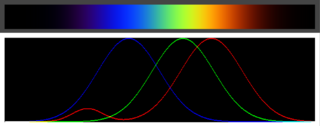Political spectrum
In politics, the political spectrum is the complete range of wavelengths and frequencies associated with the political leanings of individual humans (Homo sapiens unum) or collective groups of humans (Homo sapiens pluribus). The left-leaning Democrats traditionally (and somewhat inexplicably) associate themselves with the color blue, whilst the right-leaning Republicans prefer blondes red[1]. With clowns to the left of me and jokers to the right, here I am, stuck in the middle with you[2].
Due to the one-dimensional nature of the political spectrum, it has been conclusively proven beyond all doubt that Libertarians do not exist, and are merely the figments of a deranged imagination.
Meanwhile, everywhere else on Earth, the left marches under red banners while the right rallies beneath blue ones. Because whoever heard of a Hammer and Sickle flying on a blue background? *shudders*
The full political spectrum in all of its glory[edit | edit source]
Origins of the political spectrum[edit | edit source]
Politics (as originally formulated by the esteemed political scientist Isaac Newton) comes in a wide variety of two (2) visually-appealing colors. Just like human skin. The two (2) primary political colors were traditionally known as "red" and "blue", even well before the advent of political parties and color television in 1969. Mixing these two (2) primary political colors together in the proper proportions normally produces a disgusting shade of purple. However, Newton discovered that, by shining electric spotlights on politicians instead of randomly dousing them with buckets of paint, they (the politicians) were much more favorably disposed to rational dialogue in our uncertain world.
Political metaphysics[edit | edit source]
All politics are characterizable by three (and only three) metaphysical quantities: wavelength, frequency, and amplitude. Longer wavelengths and lower frequencies in general correlate to redness, while shorter wavelengths and higher frequencies tend go in the bluer direction. The original assignment of colors (as originally formulated by the esteemed political philanthropist Benjamin Franklin) was decided by flipping a coin. As a direct result of Franklin's enlightened wisdom, we are now stuck with this completely ad-hoc and arcane system for all eternity. Just like the electoral college. Thanks, Ben Franklin.
Wavelength and frequency[edit | edit source]
Political wavelength can in most cases be crudely estimated by the average distance of how far apart a politician hold his two hands while delivering a long-winded speech. Conversely, wavelength is inversely proportional to the frequency of how rapidly he moves his hands during that same speech. The product of these two seemingly unrelated things is approximately 12 meters per second[3] for reasons currently unclear but will be miraculously revealed for the chosen few who delves somewhat further into this immensely boring Uncyclopedia article.
Amplitude[edit | edit source]
The amplitude of a political party broadcast can be independently adjusted with the volume control, thank God. Otherwise, it has absolutely no effect on either wavelength or frequency. Thank God.
Wave/particle duality[edit | edit source]
Classical politics (as originally formulated by the esteemed political psychologist Hari Seldon) deals with immensely large public gatherings and treats the individual human being as non-existent scum. This is typically manifested in sporting-event crowds when viewed from far far away, in which wave dynamics are readily apparent with a characteristic transmission speed (cp = 12 meters per second[4]). Miraculously, this is the same exact speed which has been independently derived by completely different methods[5].
On the other hand, quantum-mechanical politics (as originally formulated by the feared and much despised Eric Cartman) concerns only the single individual and his or her or its attempted interactions with (at most) one other person. Quantum tunneling by such an individual out of an enclosed locked room can only be achieved via sufficient political motivation and/or a halfway-decent sledgehammer. The probability of successful escape is nearly impossible to calculate without a halfway-decent calculator, but has been constrained by computer-powered models to lie somewhere between 0% and 100% with approximately 80 percent confidence. The dangerous escapee then prowls around the local neighborhood in a quantum supposition of red/blue states. This phenomenon aids him in camouflaging his true irrationality, so that he can infiltrate violent mobs of peaceful protesters and get them to do his foul bidding.
Grand unification, leading to many feelings getting hurt[edit | edit source]
It was only in the latter part of 2020 when the sensible and intuitive theory of classical politics was successfully merged with the bizarre and incomprehensible theory of quantum-mechanical politics. The ill-advised merger (as originally formulated by the completely indescribable Donald Trump) led instantly to utter chaos and lots and lots of hurt feelings on both sides of the aisle. It was soon decided by every normal person in America that the ordinary "red-and-blue" divide was completely insufficient to capture the full range of political expression. Later that evening, in response to pent-up demand and bodily threats for much-needed reform, political physicists were forced to extend the official political spectrum on both ends to previously-unrealistic proportions. This was achieved, partly by inventing new and exciting metric prefixes, but mostly by shifting the blame to Satan for the worst of politically-motivated free speech.
Footnotes[edit | edit source]
- ↑ Vice versa in Limeyland, where the Tories prefer wearing ties of a more azure colour (spelt correctly) – all the while the Labourites are busy painting the town red.
- ↑ During the turbulent 1950s and 1960s, the roles of "left" and "right" changed hands several times between the major parties. However, the colors stayed basically the same because of a nationwide shortage of crayons.
- ↑ 26.84323550465283 MPH.
- ↑ 26.84323550465283 MPH.
- ↑ CAUTION: This characteristic transmission speed applies only to human audiences in a perfect vacuum. At absolute zero (-273.15 °C). And completely naked.

